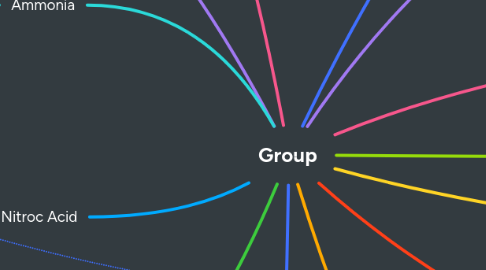
1. Occurence
1.1. Nitrogen
1.1.1. 78% by volume of atm
1.1.2. In earth's crust
1.1.2.1. Chile saltpetre (NaNO3)
1.1.2.2. Indian Saltpetre (KNO3)
1.1.3. In the form of proteins
1.2. Phosphorus
1.2.1. Minerals of apatite famile
1.2.2. present in bones as well as RNA, DNA
1.2.3. Phosphopreoteins
1.2.3.1. Milk, eggs
1.3. As, Sb, Bi
1.3.1. Mainly as sulphide minerals
1.4. Mc
1.4.1. Synthetic Radioactive element
2. Periodic Trends
2.1. Electronic Configuration
2.1.1. np2 np3
2.1.1.1. half filled orbital stability
2.2. Metallic Character
2.2.1. Down the group, Increases
2.3. Atomic and Ionic radii
2.3.1. Down the group, size increases
2.4. Ionisation Enthalpy
2.4.1. Down the group, IE decreases
2.5. Electronegativity
2.5.1. Down the group, EN decreases
3. Trends
3.1. Common O.S.
3.1.1. -3, +3, +5
3.2. Negative O.S.
3.2.1. -3, -2
3.2.1.1. Down the group, stability of -3 decreases
3.2.1.2. Mg3N2 (-3)
3.2.1.2.1. NH2NH2 (-2)
3.3. Positive O.S
3.3.1. +3, +5
3.3.1.1. Down the group, stability of +5 decreases
3.3.1.2. Down the group, stability of +3 increases
4. Physical Properties
4.1. Boiling Point
4.1.1. N < P < As < Sb > Bi
4.2. Melting Point
4.2.1. N < P < As > Sb > Bi
4.3. Except N2 all other elements show allotropy
4.4. N2 is a diatomic gas; while others are polyatomic solids
4.5. Successive IE
4.5.1. 1 < 2 < 3
5. Anomalous Properties of Nitrogen
5.1. Due to
5.1.1. small size, high IE, high EN, absence of d-orbital
5.2. N exists as N2 (g) --inert
5.2.1. But P, As, Sb forms single bonds and Bi forms metallic bond in elemental state
5.3. Catenation tendency is weak in Nitrogen
5.3.1. N-N bond < P-P bond
5.3.1.1. since N size is small; repulsion between two N atoms is high
5.4. N: pπ-pπ multiple bond with itself and other elements like C, O. 2s² 2p⁶
5.4.1. P: cannot make pπ-pπ bonds because its big. Large and diffused p-orbitals cannot overlap.
5.5. Maximum covalency --> 4 ; because of the absence of vacant d-orbital cant form dπ-pπ bond.
5.5.1. eg- NH₄⁺
6. Oxides of Nitrogen
6.1. MOP
7. Phosphorus Halide
8. Chemical Properties
8.1. Reactivity towards Hydrogen
8.1.1. Down the group, NH3, PH3, AsH3, SbH3, BiH3
8.1.1.1. Bond angle decreases
8.1.1.2. Bond dissociation enthalphy decreases
8.1.1.3. Thermal stability decreases
8.1.1.4. Basic strength decreses
8.1.1.5. Bond length increases
8.1.1.6. Reducing character increases
8.1.2. Boiling point
8.1.2.1. Directly proportional to Molecular Mass
8.1.2.2. Directly proportional to Vanderwaal forces
8.1.2.3. PH3 < AsH3 < NH3 < SbH3 < BiH3
8.1.2.3.1. due to intermolecular H-bondinf in NH3 in both (g) and (l) it has higher bp than PH3 and AsH3
8.1.3. Melting point
8.1.3.1. PH3 < AsH3 < SbH3 < NH3
8.2. Reactivity towards Oxygen
8.2.1. E2O3
8.2.1.1. Tendency to form increases down the group
8.2.2. E2O5
8.2.2.1. Tendency to form decreases down the group
8.2.3. Higher the OS, Higher the acidic character
8.2.3.1. N2O < NO < N2O3 < N2O4 < N2O5
8.3. Reactivity towards Halogens
8.3.1. EX3
8.3.1.1. NF3 stable; but NCl3, NBr3, NI3 are explosive in nature
8.3.1.1.1. Bi⁺³ > Bi⁺⁵
8.3.1.1.2. EX3 (Except BiF3 are predominantly covalent in nature)
8.3.2. EX5
8.3.2.1. N does not form pentahalide
8.3.2.1.1. Bi has less tendency to form EX5 (due IPE)
8.4. Reactivity towards Metals
8.4.1. Forms binary compound showing -3 O.S.
8.4.1.1. Ca3N2, Ca3P2, Na3As2, Zn3Sb2, Mg3Bi2
9. Phosphorus
10. Phosphine
11. Nitroc Acid
12. Ammonia
12.1. Preparation
12.2. Physical Properties
12.3. Chemical Preperties
13. Dinitrogen
13.1. Preparation
13.1.1. From Air
13.1.2. In Lab
13.1.2.1. NH₄Cl + NaNO₂ ----> NaCl + 2H₂O + N₂
13.1.3. Volcano effect
13.1.3.1. (NH₄)₂Cr₂O₇ --------heat------> Cr₂O₃ + H₂O + N₂ (orange). (green)
13.1.4. For very pure N2
13.1.4.1. Ba(N₃)₂ -----heat-----> Ba + 3N₂ (g) (barium azide)
13.1.4.2. NaN₃ ------heat----> 2Na + 3N₂ (g) (sodium azide)
13.2. Physical Properties
13.2.1. Colourless, odourless, tasteless and non-toxic gas
13.2.2. Two stable isotopes: ₇N¹⁴ ; ₇N¹⁵
13.2.3. very low solubility
13.2.4. very low freezing point and boiling point
13.3. Chemical Properties
13.3.1. Action with metals
13.3.1.1. 6Li + N₂ -----heat----> Li₃N
13.3.1.2. 3Mg + N₂ --------> Mg₃N₂
13.3.2. Action with non-metals
13.3.2.1. N₂ + 3H₂ <-------> 2NH₃
13.3.2.2. N₂ + O₂ <-------> 2NO
13.4. Uses
13.4.1. CaC₂ + N₂ ----(1000C- 1100C)-----> CaCN₂ + C
13.4.2. Used to create inert atmosphere
13.4.3. Liquid N₂ is used as refrigerant to preverve biology materials, food items and cryosurgery
